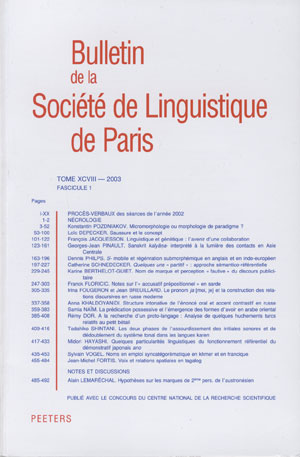 previous article in this issue previous article in this issue | next article in this issue  |

Preview first page |
Document Details : Title: Le projet LGPN-Ling Subtitle: Analyse étymologique et sémantique des anthroponymes grecs antiques Author(s): MINON, Sophie Journal: Bulletin de la Société de Linguistique de Paris Volume: 115 Issue: 1 Date: 2020 Pages: 253-297 DOI: 10.2143/BSL.115.1.3289162 Abstract : Est ici présenté le projet collaboratif LGPN-Ling d’analyse étymologique et sémantique des anthroponymes grecs antiques adossé au projet du Lexicon of Greek Personal Names d’Oxford qui consiste lui-même en l’élaboration, depuis les années 1980, du répertoire prosopographique de tous les individus porteurs de noms grecs, connus (principalement) par les inscriptions de l’ensemble du monde grec, du début de l’époque alphabétique à l’époque byzantine: environ 400000 individus identifiés, porteurs d’environ 35000 noms, aujourd’hui réunis dans huit dictionnaires organisés géographiquement (1987-2018). Notre objectif est d’offrir dans LGPN-Ling l’analyse la plus complète possible du sémantisme de chacun des anthroponymes de ce très large corpus, en allant jusqu’à reconstituer, le cas échéant, pour l’individu, les motivations qui ont pu le faire ainsi dénommer. D’une manière générale, trois raisons principales, parfois plus ou moins corrélées – sans qu’il soit possible à ce stade d’en préjuger les proportions respectives –, fondent le choix de l’idionyme: sens étymologique, d’une part, et représentations culturelles et idéologiques véhiculées par les noms propres de tous les champs de l’onomastique, d’autre part, qui sont elles-mêmes fonction des différents cercles d’appartenance de l’individu, du plus éloigné, au plus proche, le cercle familial – qui pouvait, quant à lui, le lui imposer au motif de la transmission patrimoniale. Il s’agit, dans ce cadre, d’explorer, à partir du lexique, avec lequel l’anthroponymie est en relation d’imbrication, la part plus nettement dénotative de la signification du nom et, en corrélation avec les données disponibles au-delà du seul champ linguistique, qu’elles soient prosopographiques ou relevant des autres champs de l’onomastique, c’est-à-dire géo-historiques et socioculturelles, la part plus proprement connotative de son sémantisme. Plusieurs études de cas viennent illustrer le propos: celle du nom de femme Arsinoè, qui illustre la mutabilité des significations en fonction des porteurs du nom; celle des noms Akestokypros, Lysainetè, Pheidippidès et Euarchippos, qui est l’occasion d’une réflexion critique sur les prétendus ‘composés irrationnels’ – en fait, des ‘recombinaisons’ –, et sur le recours parfois abusif au classement dans cette catégorie. Est présenté pour finir le protocole d’analyse du projet LGPN-Ling à partir de l’exemple du surcomposé Theudagoras. Here is a presentation of the LGPN-Ling collaborative project for the Etymological and Semantic Analysis of ancient Greek Personal Names. It is based on the Oxford Lexicon of Greek Personal Names, which has itself developed, since the 1980s, as a prosopographic repertoire of all individuals bearing Greek names, known (mainly) by inscriptions from the whole Greek world, from the early alphabetic period to the Byzantine period: about 400,000 identified persons, bearing about 35,000 names, currently gathered in eight dictionaries (1987-2018) organized geographically. Our objective is to offer in LGPN-Ling the most complete analysis possible of the semantics of each of the personal names in this very large corpus, going so far as to reconstitute, when possible, for the individual, the motivations which may make him or her so named. Generally speaking, there are three main reasons, sometimes more or less correlated — without it being possible at this stage to prejudge their respective proportions — for choosing the idionym: etymological meaning, on the one hand, and cultural and ideological representations conveyed by the proper nouns of all the fields of onomastics, on the other hand, which depend themselves of the different networks to which the individual belongs, from the most distant to the closest, the family circle — which could, for its part, pass on the name as part of their inheritance. In this context, the aim is to explore, from the lexicon, with which onomastics is closely interwoven, the primarily denotative part of the meaning of the name and, in correlation with the data available beyond the linguistic field alone — whether prosopographic or relating to other fields of onomastics, i.e. geo-historical and socio-cultural data —, the more properly connotative part of its semantics. Several case studies illustrate this points: is studied the female name Arsinoe, which illustrates the mutability of meanings according to its bearers; then, the names Akestokypros, Lysainetè, Pheidippidès and Euarchippos, which provide an opportunity for critical reflection on the so-called ‘irrational compounds’ — in fact, ‘recombinations’ — and on the sometimes abusive use of classification in this category. Finally, the LGPN-Ling analysis protocol is presented, using the example of the trithematic name Theudagoras. |
|


